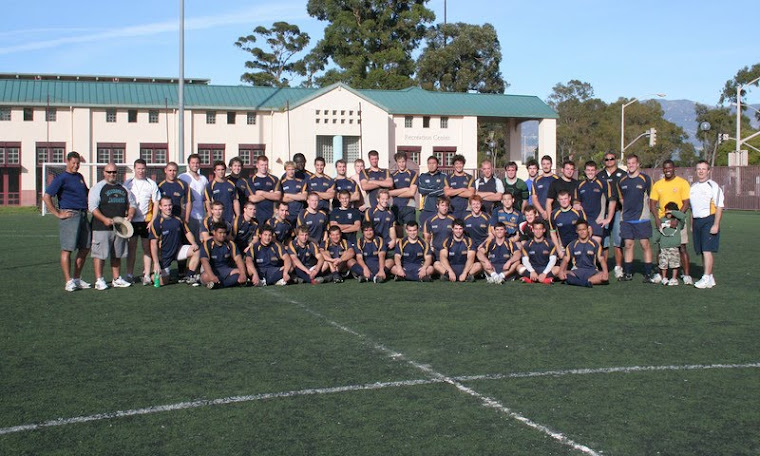 Early Gaucho Rugby
Early Gaucho Rugby“UC Santa Barbara defeats Fullerton for Southern California Championship!” announced the UCSB rugby team’s surprising 8-3 victory in the Championship match on the cement-like pitches of the 1968 Catalina Rugby Tournament. This victory heralded the arrival of the Gaucho men’s rugby team on the growing Southern California rugby scene. Not only was this the first recorded tournament championship for the fledgling program at the seaside campus, but also, it was an unlikely victory over the hardened and long-established Fullerton club side. This championship marked a significant achievement in the early days of the UCSB men’s rugby team, indicating there was much more to come. And there was!
But, first, it is important to know that this milestone championship arose from a long-standing rugby tradition in Santa Barbara. The UCSB rugby program traces its roots to the 1930’s football program at the small Santa Barbara State College. Future UCSB Hall of Fame football stars such as All-American Doug Oldershaw (1934), who went on to play professional football for the NY Giants, and All American Bob Morelli (1934-5), doubled as rugby stalwarts in the earliest Gaucho rugby sides. These Gaucho gridiron greats, coached by Spud Harder, for whom the campus stadium is named, provided athletic talent and energy to the earliest days of rugby competition in the Santa Barbara area.
Just as the State College campus on the Riviera went through a transformation in 1944 to become a full campus of the University of California, so too did rugby in Santa Barbara undergo fitful growth as a city club team over this same period. Professor Robert Kelley in his comprehensive history of UCSB (Transformations, UC Santa Barbara 1909-1979), states that at the beginning of World War II “. . . 1360 students left for the military services, which greatly reduced a campus enrollment which only had just reached 1900” (p.4). Such a dramatic reduction in students affected not only the academic development of the campus, but also its athletic and sports programs as well. As a result of the war, the early rugby tradition established at the college waned along with many other aspects of the student environment. However, participation and interest in rugby did continue in the broader community, as various rugby acolytes informally maintained their rugby pursuits through occasional matches loosely organized around a Santa Barbara City team.
According to Kelley, “Santa Barbara’s students returning from wartime service after 1945 soon swelled to a flood that, as at other college and university campuses around the nation, filled the campus to overflowing. There was not much room for this expanded enrollment on the small Riviera campus” (p.7).
By the mid-1960s the surging campus moved to 408 acres on Goleta Point and became a full general campus of the University of California. These changes brought an increasingly varied student population, including some with previous rugby experience. The University expanded offerings and opportunities in academics, athletics, the arts, and recreation. As primarily a residential campus, team sports and intramurals were very popular with the students. Men’s rugby re-emerged as one of those sports organized through the department of recreation. Organizational impetus came from outside the student body as well. Having doubled as football and rugby athletes at Stanford and Cal respectively, Rod Sears and Rudy Carvajal arrived at UCSB in 1966 as newly hired assistant football coaches. With their experience in long-standing programs, they provided invaluable support and guidance to the newly developing Gaucho rugby club. By 1967, student interest in rugby was growing. With the likes of future rugby All-American John Keever, and a cadre of his teammates from the successful football program, many of whom had participated in the Camellia Bowl, winning habits and tenacity quickly became characteristics of Gaucho rugby. Sears’ ability to navigate the bureaucracy of both the University and the Southern California Rugby Union, along with his tireless efforts to recruit new players, provided invaluable support to enable Gaucho rugby to quickly became a viable athletic program at UCSB.
Success was immediate. By the end of the 1967-68 season, the Gauchos were full members of the Southern California Rugby Union, vying for the league championship. They enjoyed a 12-7 record overall, including victories over more established sides such as Eagle Rock, Occidental, and San Diego State. The tournament victory at Catalina at the end of the season capped the year’s success.
In 1969, a Gaucho sudden death thriller over the venerable Los Angeles Rugby Club (20-17) at the same Catalina Championship Rugby Tournament cemented the club’s reputation as an up and coming collegiate powerhouse.
In 1970, the site of the Southern California Rugby Championship Tournament moved to UCSB, where the Gauchos would have an opportunity to defend its two-year-running success on their home turf in Harder Stadium. A new chapter of the Gaucho rugby tradition was about to open as the tournament would grow and develop to become the Santa Barbara International Rugby Tournament, one of the largest and most popular 15 a-side tournaments in the world.
Tune in later for future articles on the rich history and lore of Gaucho men’s and women’s rugby at UCSB.
Cheers,
Mel Gregory
Parvi sed Lenti

No comments:
Post a Comment